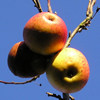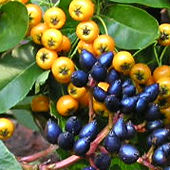10 November 2001
Waheyy! There's a frog
in my mini-pondette!
I made a small pond in August, a product of one weekend's enthusiasm and
some thick polythene I didn't know what to do with.
I knew the small
pond I'd made was too near to trees, and that in autumn I would have
to cover it or regularly clear it of fallen leaves. This week I decided
I should tackle this, and fish them out. There were a few I could feel
had fallen to the bottom, in the soil down there around the roots of the
plants. I was fishing about trying to locate them, with the aid of a small
plastic garden sieve.
In a pause, when I wondered why I was bothering with this glorified puddle,
I noticed a frog's head had appeared just above the water.
I have also, in a previous year, had the privilege of meeting a toad
in the garden. Having met the toad and thinking
it was a frog, I was very pleased on this occasion to realise that
I was absolutely sure that this frog was a frog.
Collecting leaves
As someone whose roses always get blackspot or rust, and whose fruit
tree is of doubtful health, I am advised to collect up and throw away
all diseased leaves. This being recommended as an organic way of helping
to keep diseases down, as the leaves will spread the diseases from one
year to the next. And this year, and next, and as long as I'm 'in charge',
no chemical pesticides or fungicides are allowed near my plants.
Diseased leaves, fruit tree leaves, leaves from roses, shouldn't be added
to the compost heap. Yet, conversely, composting all green garden waste
is important.
As an avid compost-maker for several years now, I hate throwing away any
vegetation that comes from my garden. So I have a dilemma.
Okay, so I will throw away the diseased leaves, and compost the rest.
Great plan.
Would work if each tree or rose was 10 metres from every other plant,
with a 10 metre high fence around it. In reality, certainly in any garden
with a well-established planting, every plant is intermingled with everything
else, and the autumn winds ensure that all leaves are blown together in
great indiscriminate heaps.
So I'm collecting handfuls of fallen leaves each year, trying to keep
the leaves of the Virginia creeper for recycling into compost, finding
in each handful a few of the leaves from the nearby rose, spotted with
blackspot or rust. I have a handful of leaves, a potential source of organic
matter to be returned to enrich the soil of my garden. I also have a handful
of leaves which is a potential bio-hazard transmitting blackspot, rust
and mildew to next year's roses.
What's a gardener to do? Collect each and every leaf individually, adding
the non-diseased to the compost, the others to the bin? Take the diseased
stuff to the 'green waste' disposal facility at the local tip, feeling
vaguely troubled at the thought of passing on all that rust/blackspot/
canker/mildew?
And recently our council has added a further option/problem, by providing us with an enormous wheelie bin. It's sitting there like a rather malevolent presence, demanding to be filled.
At night the wheelie bin peers in through our window, its great jawlike lid flapping open, saying 'I'm an enormously over-sized disposal device. I have extra room for all the green stuff you can't be bothered to compost or take to the tip. Fill me with those rusty mildewed leaves!'
The organic gardener's life is such a complex one, filled with ethical
dilemmas and competing waste disposal options. No wonder I feel so tired.
Back to November highlights and diaries


